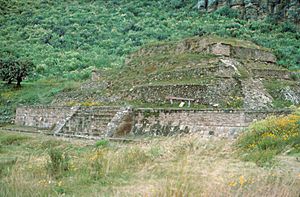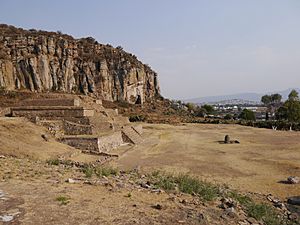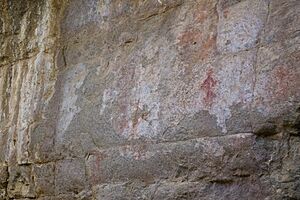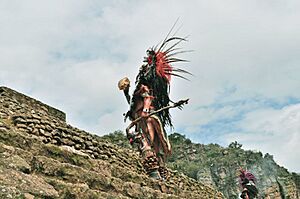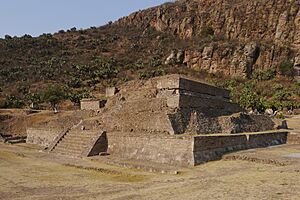Huapalcalco facts for kids
Huapalcalco is an ancient archaeological site in Mexico, located about 5 kilometers north of Tulancingo in the state of Hidalgo. It was built on the side of a hill called "Tecolote." The site is divided into different areas by a natural ditch, showing ancient structures both at the bottom and on top of the hill.
This important place shows influences from the Teotihuacan culture. Some people believe that a famous leader named Topiltzin Quetzalcóatl might have lived here before he ruled the city of Tula. Huapalcalco is also considered the oldest place where humans lived in the Hidalgo State.
Archaeologists think Huapalcalco was a very important center for daily life, religion, and housing. It is even thought to have been the second capital of the Toltec Empire, before Tula. The city was founded by the Olmeca-Xicalanca people, who were some of the first tribes to settle in the central mountain plateau. The exact purpose of some of its wooden buildings is not fully known, but they might have been used for military training, justice, or learning dances and music.
Evidence shows that people arrived in the Mexican plains about 30,000 years ago. Around 13,000 years ago, humans reached Huapalcalco, leaving behind traces of their lives. Huapalcalco was a key site during the Mesoamerican Classical period (100 to 650 CE). While it was part of the Teotihuacan state, its buildings and pottery were unique, showing Teotihuacan influence but not being exactly the same. The culture that built these monuments is still a bit of a mystery, but it was clearly connected to Teotihuacan and also influenced by cultures from the Gulf Coast.
Quick facts for kids Olmec (Xicalanca) Culture – Archaeological Site |
||
| Name: | Huapalcalco Archaeological Site | |
| Type | Mesoamerican archaeology | |
| Location | Huapalcalco, Tulancingo, Hidalgo |
|
| Region | Mesoamerica | |
| Coordinates | 20°07′01″N 98°21′45″W / 20.11702°N 98.3624°W | |
| Culture | Olmeca-Xicalanca – Toltec | |
| Language | ||
| Chronology | 100 – 650 CE | |
| Period | Mesoamerican Preclassical, Classical, Postclassical | |
| Apogee | ||
| INAH Web Page | ||
Contents
Ancient Times in Huapalcalco
During the Lithic period (10,000 - 3500 BCE), the first signs of human hunter-gatherers appeared in the valley. Later, in the Archaic period (8000 – 2000 BCE), the first human settlements began to form in Mesoamerica, along with the start of farming.
The Pre-classical, or Formative Stage, saw the rise of the first major civilization, the Olmecs, from about 2000 BCE to 250 CE. During the Classical period (250-900 CE), Tulancingo became an important trading hub with roads and homes. This is when Huapalcalco was built. Today, only a three-sided pyramid and a staircase, built in the Toltec style, remain.
Ancient Cave Paintings
The oldest cave paintings in the area are found on the Huiztle hill and the Huapalcalco plateau. These paintings show us what life was like for early groups, with pictures of people, simple drawings, and astronomical figures that date back to 9,000 BCE.
One painting shows a lizard and people. Another shows a person using an ancient spear-thrower called an "atlátl." This was a javelin-like weapon with an arm extension, used mainly to hunt ducks that were once plentiful in a nearby lagoon. These early people were hunter-gatherers, meaning they hunted animals and gathered plants for food. They didn't keep animals as pets but knew how to hunt and use fire for cooking.
The Legend of Huapalcalco
There's an old legend about the city of Huapalcalco, sometimes called Coapalcallico. The story says the gods punished the city because its people couldn't defend it from invaders. Other civilizations built new structures right over their old ones.
The gods were very angry about this, so they completely buried the city. The legend says this city was huge, covering an area of about 10 square kilometers, from Huapalcalco all the way to Abra, Santiago, and Acatlán today.
To lift the curse, the gods told the shamans there was only one way. On June 24th, exactly at midnight, a magical bridge would appear between the two Coapalcallico hills, right over the main pyramid. At that exact moment, a person with the purest and bravest heart could cross the bridge. On the other side, they would find a golden chain. If they pulled the chain, the city, buried by the gods' curse, would reappear.
Tulancingo: A City Through Time
Tulancingo was an important city even before the famous Teotihuacan civilization. Its name comes from the Nahuatl words "tule" and "tzintle," meaning "in or behind the reeds." This is even shown in its Aztec symbol.
This area is home to some of the oldest settlements in Mesoamerica, like Huapalcalco and El Pedregal. These first settlements are thought to have been made by the Olmecs, Xicalancas, and other tribes. The city of Tulancingo was officially founded in 645 BCE by the Toltecs. It was part of their empire, which was centered in Tula. During this time, Tulancingo had schools and temples. A special calendar stone was carved here, and a temple called Mitlancalco was built to honor priests and princes. After 1116 CE, the Toltec empire weakened, and the city was left empty.
According to ancient records, the Tulancingo area was a busy trading center for the Otomi-Tepehua and Totonac people around 1000 CE. Traders came from places that are now the states of Hidalgo, Puebla, and Veracruz. This tradition of trading still continues today with the Thursday "Tianguis" or market.
Around 1120, the Chichimecas, led by King Xolotl, came to rule this area. They rebuilt the city along with the remaining Toltecs. The population grew even more when the Tlaxcaltecas arrived. In 1324, a king named Quinantzin reorganized the area, making Tulancingo the main city of a province. Tulancingo fought against Texcoco but was defeated. In the early 1400s, Texcoco, under its leader Huitzilihuit, conquered Tulancingo, making it part of the powerful Aztec Empire. In 1431, the Tulancingo area was again reorganized by Itzcoatl and Nezahualcoyotl.
Eventually, Tulancingo became part of the Texcoco empire and was later taken over by the mighty Aztec empire in 1416. From then on, Tulancingo was split into two parts: Tlaixpa, in the east, mostly lived in by native Otomi people; and Tlatoca, in the west, where Nahua people lived. People from both sides paid tribute to the Aztec kingdom, usually in the form of cotton blankets and seeds like corn and amaranth.
Even though Tulancingo paid tribute to the Mexicas (Aztecs), it still had some freedom in how it was run. They could choose their own leaders. This city was also an important place for the Aztecs to store food.
The Olmec-Xicalanca People
The middle part of the Classical period in Northern Mesoamerica ended around 700 CE when the great city of Teotihuacan declined. This allowed other regional powers to grow and compete for control over trade routes and natural resources. This time was known as the Late Classic era. It was a period where no single city had complete control. Many groups of people moved around during this time. Some came from drier northern regions, pushing older Mesoamerican populations south. Among these new groups were the Nahua, who would later build the famous cities of Tula and Tenochtitlan, which were very important in the Postclassical era. Also, groups from the south settled in central Mexico. One such group was the Olmec-Xicalanca, who came from the Yucatán Peninsula and founded cities like Cacaxtla and Xochicalco.
The term Olmec-Xicalancas refers to a specific culture (not to be confused with the much older Olmec civilization). They lived in and influenced nearby areas. A unique thing about the Olmec-Xicalancas was that each group (or city-state) was ruled by a "tahualz," which was like a king or ruler, independent of others. In fact, each city-state often had two tahualz.
They had a writing system with at least 10 symbols, including pictures of the Sun, Moon, a tree, a field of crops, and a person. Their religion involved many gods, with the Sun God being the most important, though called by different names in different villages.
Other places influenced by the Olmec-Xicalanca culture include:
Exploring the Site
Huapalcalco was active during the Mesoamerican Classical period (100 to 650 CE) and was part of the Teotihuacan state. However, its buildings and pottery are different from those found in Teotihuacan. This means it was influenced by Teotihuacan but wasn't built by them. We don't know for sure who built these monuments, but they clearly show a strong connection to Teotihuacan culture and also influenced other cultures along the Gulf Coast.
Archaeological Discoveries
The northwestern part of the site, which might be the most important, was explored in the 1950s by archaeologists Florencia Jacobs Müller and Cesar Lizardi Ramos. After many trips, they found a group of pyramid-like monuments that clearly showed Teotihuacan influence. They also found a plaza with a Stele (a tall stone slab, showing Mayan influence), Totonac yokes (U-shaped stones), and a round altar.
Finding Totonac yokes was important because it showed influence from cultures on the Gulf of Mexico coast. They also discovered a sculpture of the Teotihuacan God of fire.
An exciting discovery was made when digging deep into one of the buildings: arrowheads of the "meserve" type. These date back to a culture from 7,000 BCE, before pottery was made. This matches a prehistoric hand axe found in a burnt cave in the "el Tecolote" hill cliffs. In this cave, cave paintings with geometric human figures, mostly in red, were also found. This proves that early humans lived in Huapalcalco around 10,000 BCE.
Recently, on the highest part of "El Tecolote" hill, a pyramid foundation made of stone slabs and stucco was found. Another similar monument, not yet explored, is on the other side of the ravine. Locals call this area "iglesias viejas" (old churches).
Huapalcalco covers about 39 hectares, but the main archaeological site is within a protected 4-hectare area.
What's in a Name?
The name Huapalcalco comes from the Nahuatl language. "Huapalli" means "board or small beam," "calli" means "house," and "co" means "place." So, Huapalcalco means "place of the wooden house."
The symbol for Huapalcalco is a building with battlements (like a castle wall) and three doors, which seems to be made of wood. This is different from the usual "calli" (house) symbol. It represents the idea of a "huapalcalli," which means "tent or house of tables."
Buildings and Features
The site has a three-sided pyramid, influenced by Teotihuacan, which is 12 meters wide at its base and 8 meters tall. It has an altar that might have been used for special offerings.
There are also about 28 "knolls," which are small, buried pyramids that haven't been explored by archaeologists yet.
The hill slope is divided by a ravine. An old account by Friar Bernardino de Sahagún described this place, saying it "has clear water cascades, at the foot of stones, women were washing clothes while children swam and plunged into water."
The cave paintings are found on the stones above the ravine, spread out over "Cerro La Mesa" behind the pyramid. Sadly, some have been damaged by graffiti, making them hard to see. Also, local people have painted white crosses on the stones, believing it scares away witches and "nahuales" (shape-shifters).
On the slope, among the rocky cliffs, there are caves. Villagers often place altars inside these caves to honor their ancestors. In front of the "Tecolote" Cave, the remains of a prehistoric man were found. Carbon-14 tests show this man lived here 10,000 years ago. His remains are now kept in the Prehistoric Room of the National Museum of Anthropology and History in Mexico City.
See also
 In Spanish: Huapalcalco para niños
In Spanish: Huapalcalco para niños


